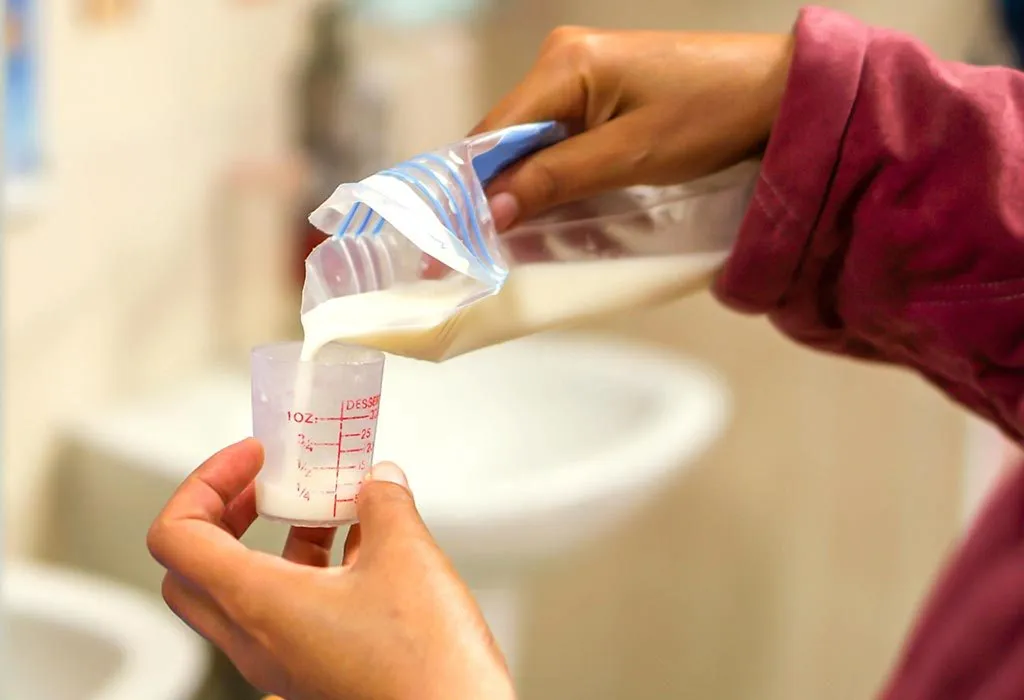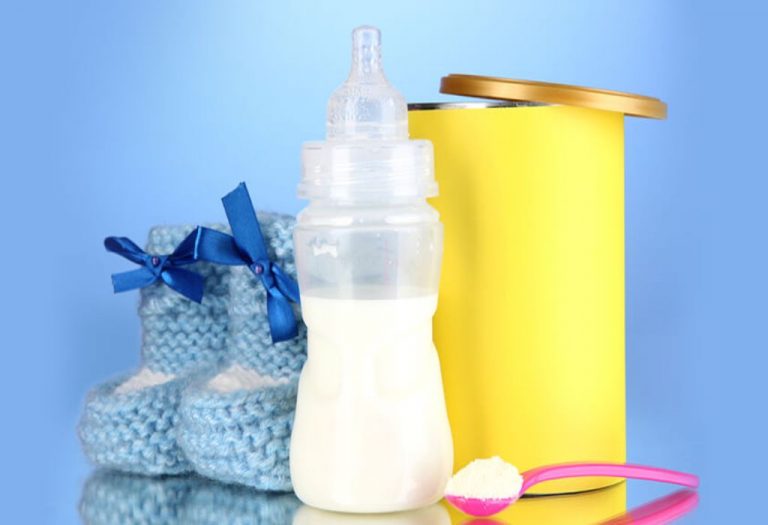Cup Feeding Your Baby – Benefits and Drawbacks

‘Can I feed my baby with a cup?’ is a common unasked question among mothers, especially from those going through their first pregnancies. Although the answer is yes, there is a caution and preference attached to it. Cup feeding is an effective alternative feeding method to feed a breastfed or bottle-fed baby. Cup feeding a baby is an uncommon practice because it is not usually used for babies in general. It is especially useful for feeding premature babies and when mothers are unable to breastfeed. Cup feeding is not new and has been used for hundreds of years by women around the world. So, is cup feeding a baby a safe practice, and even if it is, is it ideal? Let’s find answers to all your questions in the following post.
What Is Cup Feeding?
Cup feeding, as the name suggests, is a method to feed the baby using a cup who is unable to drink from the teat or cup (1). Any cup that can hold milk will do, be it your teacup, the cap that covers the feeding bottle, a shot glass or a plain cup. With the baby seated in an upright position, the cup is filled just enough to let him take sips of the milk comfortably. The World Health Organisation’s recommendation on infant feeding suggests that cup feeding is a better method than feeding with a bottle and teat.
Which Babies Need Cup Feeding?
While cup-feeding is suitable for any baby, it is recommended only if breastfeeding is not possible (because breastfeeding by itself offers a lot of benefits). Consider cup feeding in the following situations (2):
- Premature, weak or sick babies that do not yet possess the strength to take all their milk from the breast. Cup feeding can be used with excellent results with such babies (3).
- Babies that have trouble with suckling from the breast for various reasons such as sleepiness, tiredness, inverted nipples, tongue ties, latching problems, etc. Cup feeding gives you an alternative while you work on your breastfeeding problems in such cases.
- When mothers have to give expressed milk to babies within the first 6 weeks or so, breastfeeding isn’t yet well established.
- Mother is unable to feed as she needs to travel or has soreness from a cracked nipple and offers expressed milk.
Benefits of Cup Feeding Your Infant
Here are some reasons why cup-feeding your infant would be a good idea (as compared to bottle-feeding):
1. Cup-Feeding Does Not Interfere With Direct Breastfeeding
One of the biggest advantages of cup feeding is that it avoids nipple confusion in babies. Nipple confusion happens when babies are introduced to artificial teats from bottles. Since artificial teats use a different sucking mechanism that requires less effort when compared to breasts, babies might reject breasts and jeopardize the breastfeeding relationship.
2. Cup Feeding Prevents Misalignment of Teeth and Abnormal Development of the Jaws
Feeding bottles are known to alter the way teeth and jaws develop in babies. The different sucking mechanisms from artificial teats can cause misalignment of the teeth as the babies grow. This has repercussions in the form of poor oral performance, such as speech, eating, and breathing. Cup feeding can prevent these misalignments and prevent abnormal development.
3. It Is Safer and Helps Reduce Dental Caries
All teething babies like to bite and gnaw. The artificial nipples on the bottles are great for gnawing on, and sometimes, parents find that their babies would have bitten off a piece of the nipple. This can be dangerous as the piece is a choking hazard. It is also seen that bottle-feeding can lead to tooth decay in babies who have their growing teeth soaked on artificial nipples.
4. Prevents Over-Feeding of Babies
Although it is easy to learn, cup feeding requires more effort on the part of the baby to get milk. When feeding, you will have to bring the cup to the baby’s mouth and tilt it up until the milk touches the lip. Then, let the baby lap it using his tongue into the mouth. This prevents overfeeding as opposed to bottle feeding, which drips milk into the mouth. It is beneficial for the babies as they can better regulate their intake, feed only as much as they need, and avoid force-feeding. Some feeding cups are also graduated, so you can measure the exact quantity of milk you want to feed your baby.
5. Eliminates the Need for Special Cup Training in the Future
All babies will eventually have to grow up and learn to use a cup. This is one task that’s no hurdle to cup-fed babies as they can effortlessly drink from training or sippy cups.
6. It Is Affordable
Feeding on cups eliminates having to buy expensive feeding bottles and teats. Cups are also easy to clean, maintain, and carry around.
How to Cup Feed a Baby?
Cup feeding is best taught by a healthcare professional through a demonstration; therefore, consult with them before you begin. Also, ensure your baby is awake, alert, and in an upright position when you cup-feed him. Never pour milk in their mouth or feed a baby who is lying flat on the back.
Here is how to cup-feed a breastfed baby (4):
- To start with, you’ll need a soft-spouted cup that is smooth on the baby’s lips and tongue. A bib is also a must-have to catch any dribbles.
- Half-fill the cup with slightly warm formula or breast milk.
- Ensure the baby is in an upright position in your arms or lap. Wrap them if necessary to prevent them from knocking the cup out of your hands.
- Bring the rim of the cup to the baby’s lower lip or the lower gum ridge.
- Tip the cup gently so that the milk reaches the cup’s rim but doesn’t pour into the baby’s mouth.
- The baby will quickly learn to lap or sip the milk off the rim of the cup with their tongue.
- Keep the pace slow and pause when the baby swallows. Let them take more sips.
- Avoid putting pressure on the lower lip or pouring it into the mouth.
- Continue feeding at the baby’s own pace and let them sip whenever they can.
Disadvantages of Cup Feeding Your Child
Cup-feeding a baby has disadvantages, too; find out what they are before you cup-feed your baby.
- There is a risk of choking or spitting up if the feeding is done improperly.
- There is more wastage of milk due to spilling than in bottle, tube, or syringe feeding.
- Feeds take longer, and long-term use might develop a preference for it over sucking milk from the breast.
Transitioning From Cup Feeding to Breastfeeding
Transitioning from the cup to the breast depends on why you started cup feeding in the first place. Occasional cup feeds between successful breastfeeds are just fine. However, if you’re using the cup because your baby doesn’t take the breast, then you will have to work to breastfeed them. This transitioning might also be necessary for weaker babies (low birth weight babies, preemies, etc.) who had to start with cup-feeding before they gained the strength to be able to breastfeed. Offer them the breast before every cup feed, and offer it in between the cup feeds (or at any time the baby seems interested). Once they begin taking the breast, cup feeding can be done if they want a little more milk.
Alternatives to Cup Feeding
If you want to try other methods of feeding your baby, here are some options (5):
- Syringes are effective and are easier than cups to feed a baby.
- Indian mothers have used ‘paladai’ for centuries to feed their babies. It’s basically a small spouted cup to feed small quantities of milk at a time and about just as effective as syringes.
- Teaspoons can also be used to feed babies as an alternative. It works well when the baby is calmer and taking milk without much fuss. It’s also useful to feed colostrum in the first few days when you can express it directly into the spoon.
FAQs
1. What are some important things to be kept in mind while cup-feeding a baby?
Before feeding a newborn with a cup, make sure your hands are thoroughly washed and dried. Secondly, ensure the baby is awake and is all ready to feed from a cup. Fill the cup two-thirds only with expressed breastmilk or formula milk and feed slowly (6).
2. What are other benefits of cup feeding a low birth weight baby?
According to the WHO, cup-feeding enhances the scale of exclusive breastfeeding at the time of discharge. Since cups are easier to wash and clean compared to baby bottles, the cup-feeding practice could also reduce the chances of infections like diarrhoea (3).
3. When should you start cup-feeding your baby?
Cup feeding 2 to 6-month-old babies is a common thing. However, according to La Leche League International, babies can be cup-fed since birth (4).
4. How long should I cup-feed in one feeding?
You should not cup-feed your little one for more than 30 minutes per feeding session (1).
Cup feeding is an excellent alternative to breastfeeding in babies and can be tried after consulting with a doctor. Whatever you decide upon, make sure to tune in to your parental instincts for the well-being of your baby rather than following the trend.
References/Resources:
1. Cup-Feeding Baby With Breast Milk or Formula; HealthLinkBC; https://www.healthlinkbc.ca/pregnancy-parenting/parenting-babies-0-12-months/feeding-your-baby/cup-feeding-baby-breast-milk-or
2. Cup-feeding; Australian Breastfeeding Association; https://www.breastfeeding.asn.au/resources/cup-feeding
3. Cup-feeding for low-birth-weight infants unable to fully breastfeed; WHO; https://www.who.int/tools/elena/interventions/cupfeeding-infants
4. Cup feeding; La Leche League International; https://llli.org/news/cup-feeding/
5. Cup Feeding; Globa; Health Media; https://globalhealthmedia.org/videos/cup-feeding/
6. Cup Feeding Infants During Emergencies; CDC; https://www.cdc.gov/infant-feeding-emergencies-toolkit/php/cup-feeding.html
Also Read:
Bottle Feed a Baby
Finger Feeding Your Baby
Newborn Baby Feeding and Sleeping Schedule
Age Wise Guide to Feeding Your Baby – 0 to 12 Months
Was This Article Helpful?
Parenting is a huge responsibility, for you as a caregiver, but also for us as a parenting content platform. We understand that and take our responsibility of creating credible content seriously. FirstCry Parenting articles are written and published only after extensive research using factually sound references to deliver quality content that is accurate, validated by experts, and completely reliable. To understand how we go about creating content that is credible, read our editorial policy here.
























